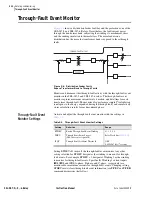
5.23
Date Code 20050919
Instruction Manual
SEL-387-0, -5, -6 Relay
Metering and Monitoring
Through-Fault Event Monitor
Setting THRU triggers the through-fault event-the through-fault event
monitor starts acquiring maximum current and duration information, along
with a date/time tag. Typically, the THRU setting is set with an overcurrent
element. For example, set THRU to trigger a through-fault event on the
pickup of a phase instantaneous overcurrent element on Winding 2:
THRU =
50P23
To block triggering of through-fault events resulting from transformer inrush,
consider settings such as
THRU =
50P23 * !87BL
shows the time progression of a through fault, such as that in
. Typically, SEL
OGIC
setting THRU would be set to some
instantaneous overcurrent element (e.g., THRU = 50P23). When THRU
asserts at the outset of the through fault, event duration timing begins. When
THRU de-asserts (e.g., the distribution feeder breaker interrupts the fault),
through-fault event duration timing ends and the duration time is recorded for
that event.
If SEL
OGIC
setting THRU is asserted (by whatever means), then maximum
currents are recorded for the monitored current inputs.
shows the
current jumping up to a short-term maximum before being interrupted
(perhaps the feeder fault “burned through” and became more “bolted”). This
short-term maximum current, which occurred within the duration timing, is
what gets recorded for the particular monitored phase.
Figure 5.7
Through-Fault Triggering, Duration, and Maximum Current
Through-Fault
Calculation
The through-fault event monitor uses the recorded duration time value and
maximum currents to perform simple I
2
t calculations and cumulatively store
results of these calculations for each monitored phase. For example, if a
through fault is 6000 A primary (maximum) and lasts 0.067 sec., the monitor
would calculate I
2
t for that event as follows:
Equation 5.8
If the above calculation were for the example in
, it would be a
conservative calculation (i.e., the calculation would indicate more I
2
t stress/
wear than actually occurred). This is because the current peaked momentarily.
NOTE:
The above examples show the
designated current inputs
(ETHRU = 2) and triggering element
(THRU = 50P23) both from Winding 2.
While this is a common setting
approach, triggering elements can be
from any winding or be of any element
available in
(e.g.,
THRU = IN101; set to trigger a through-
fault event on the assertion of input
IN101
).
Through-fault
event duration
(SEL
OGIC
setting THRU asserted)
trigger
max.
current
I
t
6 kA
(
)
2
0.067 sec.
• 2.412
(kA)
2
seconds
=
Содержание SEL-387-0
Страница 10: ...This page intentionally left blank ...
Страница 16: ...This page intentionally left blank ...
Страница 56: ...This page intentionally left blank ...
Страница 350: ...This page intentionally left blank ...
Страница 388: ...This page intentionally left blank ...
Страница 456: ...This page intentionally left blank ...
Страница 494: ...This page intentionally left blank ...
Страница 528: ...This page intentionally left blank ...
Страница 536: ...This page intentionally left blank ...
















































